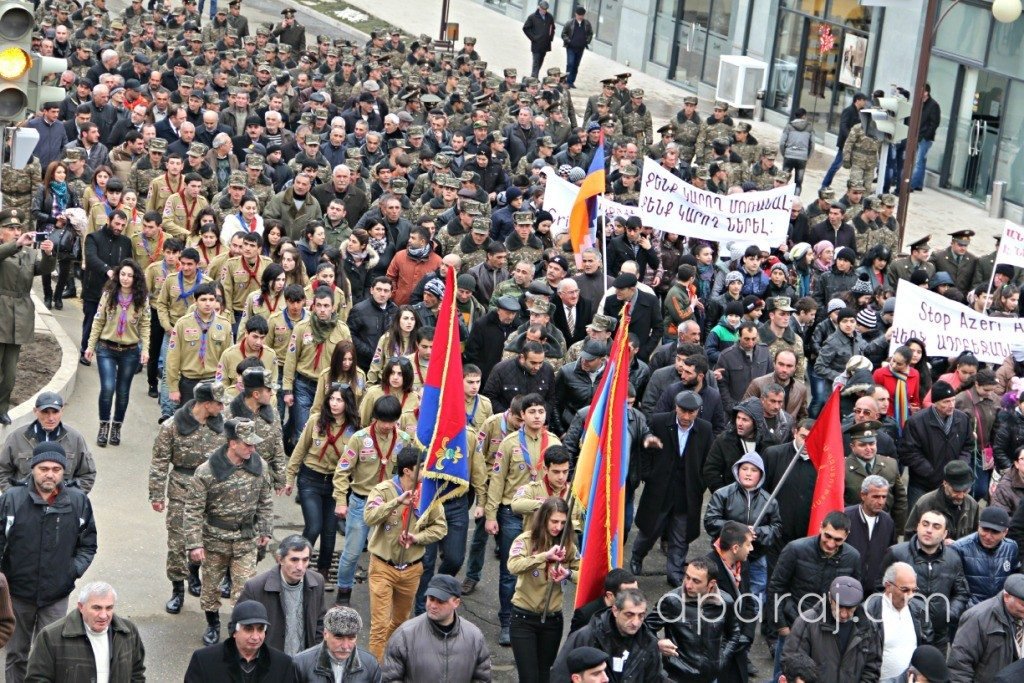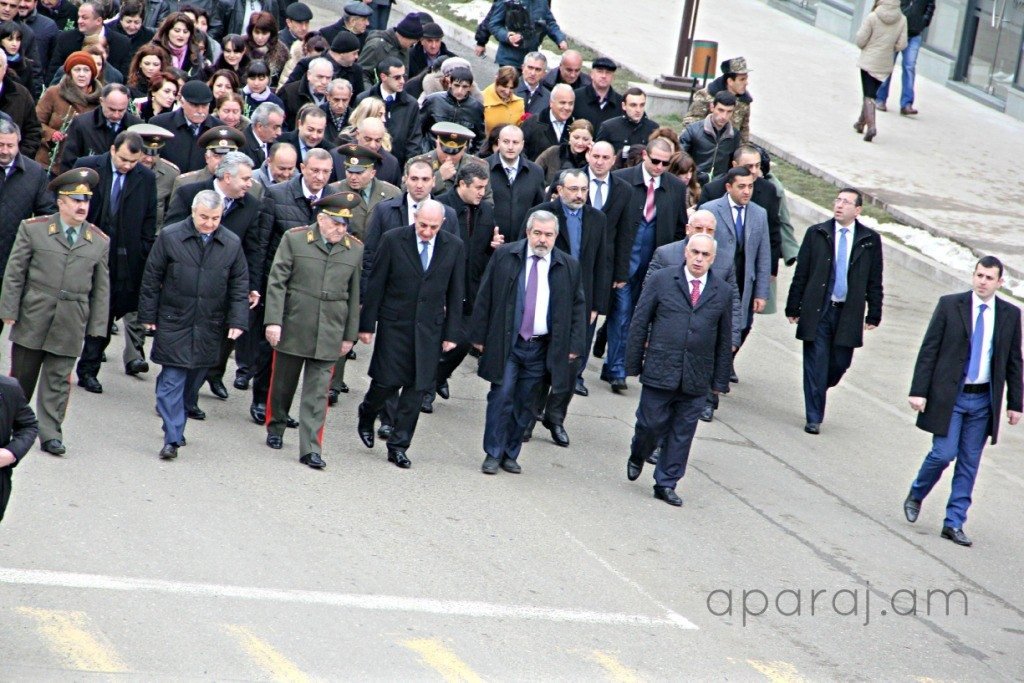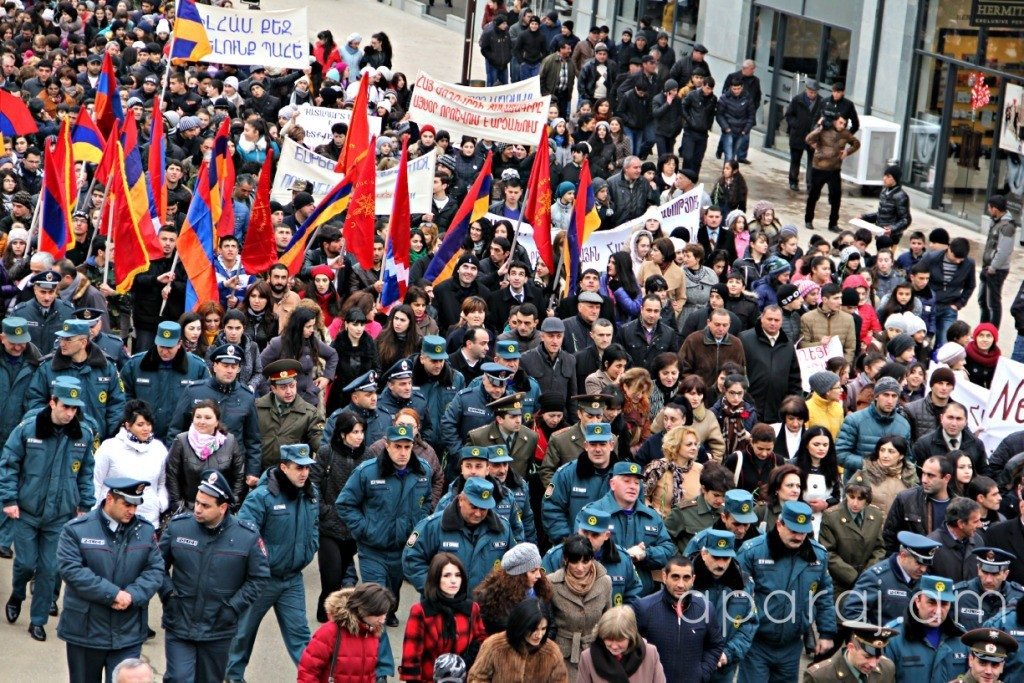STEPANAKERT (A.W.)—Around 1,200 members of the Armenian Revolutionary Federation-Dashnaktsutyun (ARF-D) joined high-level officials and citizens in Nagorno-Karabagh (Artsakh) on Feb. 27 to commemorate the 27th anniversary of the Sumgait anti-Armenian pogroms, which took place in 1988.
More than 1,000 ARF-D members traveled from Armenia to Artsakh to participate in the commemoration events, carrying a message of solidarity.
Artsakh President Bako Sahagyan, Speaker of the National Assembly Ashot Ghulyan, high-level officials, and clergy—including Primate of the Artsakh Diocese of the Armenian Apostolic Church Archbishop Pargev Martirosyan—visited the Sumgait Memorial site in Stepanakert, where they laid flowers. ARF-D Bureau Chairman Hrant Markarian led the visiting party members in the commemoration events, reported YerkirMedia.

Sahagyan met with the ARF-D representatives and a delegation of Artsakh War veterans from Armenia, as well as members of Armenia’s National Assembly.

Speaking with the Armenian Weekly on Feb. 25, ARF-D Bureau member Giro Manoyan said the purpose of the visit was to express support for Artsakh. “The visits to the military units and outposts are aimed at bringing attention to the constant ceasefire violations by Azerbaijan and expressing support to our soldiers who are defending the borders and the line of contact. The meetings with the Republic of Artsakh leadership are also to express support to Artsakh,” said Manoyan.
2014 was the bloodiest year in the Nagorno-Karabagh conflict since the 1990’s, with 39 Azerbaijanis and 33 Armenians killed. By comparison, the previous worst year on record, 2012, saw 14 Armenian and 20 Azerbaijani soldiers killed.
This year marks the 27th anniversary of the deadly pogroms of Sumgait, which took place on Feb. 27, 1988. The pogroms are considered the beginning of a systematic campaign by Azerbaijan’s OMON Special Forces to use mass violence to uproot Armenians from Azerbaijan and Karabagh. The Sumgait tragedy and its violent repetitions throughout the country between 1988-91 led to the disappearance of 450,000 Armenians living in the long-established Armenian community of Azerbaijan.




While we commemorate the tragedy of Sumgait, we should not forget the role played by the Russian (at the time called “Soviet”) government in the massacre. As always, Armenians had placed their full faith in the Russians and Gorbachev when we started the Karabakh movement. In return, when the massacre started, the Russian troops mysteriously waited for three days (while the killings continued) before moving in. As many realized later, this was deliberately done to “teach Armenians a lesson.” Indeed, it was a pattern that Russia had often employed throughout the history: throw Armenians into the lion’s mouth whenever it suited their interests.
Fortunately, Armenians exhibited remarkable (and some would say rare) political astuteness by democratically overthrowing the puppet Communist regime in Armenia, despite all the usual calls that “it would be the end of Armenia” (including a notorious speech by Catholicos Vazgen I). Instead, the new democratic spirit unified Armenians to an unprecedented degree and led them to a remarkable victory against the enemy. And then, a stronger Armenia was able to ally itself with Russia on a more equal footing. A lesson from our history that we should not forget.
Which brings me to another tragedy that we should also commemorate these days: the martyrdom of innocent Armenians on March 1, 2008, who died for a chance to make Armenia a democracy, i.e. a country where Armenians would want to live in.
Another in the series of desperate make-believe manufactured fakestories by our քոչվորoğlu guest from Baku Khanate, to blame everybody else for the murders and massacres of defenseless Armenian civilians in Sumgait, Kirovabad, and Baku by……surpriiiise…his Turkbaijani kin at the Caspian Sea gas station.